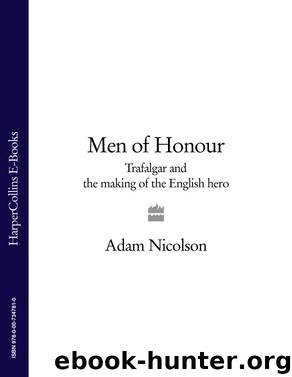Men of Honour by Adam Nicolson

Author:Adam Nicolson
Language: eng
Format: epub
Tags: Fiction
Publisher: HarperCollins Publishers
This extraordinary passage, written by Fielding in 1751, part of his Inquiry into the Cause of the Late Increase in Robbers, might be the template on which the heroic figure of Nelson himself was based. Every single keyword and key phrase of the Nelsonian amalgam is there: hero, pride, passion, ‘the day of glory’, ‘his last moments’, ‘triumphant’, ‘the compassion of the meek and the tender-hearted’, ‘applause’, ‘admiration’, ‘envy of all the bold and hardened,’ ‘his death spoken of by many with honour, by most with pity, and by all with approbation.’ It is as if, half a century before, the appetite was there among the mob in the streets en route to Tyburn for the kind of figure which Nelson would provide them in the late 1790s and early 1800s. The public figure of Nelson is modelled not on the Newcastle-Byng template, the big, solid, respectable, prudent and lying establishment, but on the bold, brave, tricky, clever, daring, nimble-minded and nimble-fingered, counter-culture hero of the thief.
The appetite for such a hero was certainly there, but the 18th-century cult of gentlemanly courtesy could not satisfy it. It was fed by a stream of twopenny broadsheets and sixpenny pamphlets, filled with journalistic accounts of criminals in Newgate prison in London. For sale singly or bound in collections for a shilling, by 1760 almost 1,300 of these Newgate prison lives had been published. Men of charm, wit, honour, violence and great professional skill, with a protean ability to appear and disappear, with no social standing, money or education, alert for captures, prizes and victories, ready to risk all for the glory of their triumphs: more connects the image of the naval hero and the thief than divides them. There is, in other words, something in the national hero of 1805 which looks like an adopted and legitimised criminality. Nelson and his band of brothers might be seen as a set of sanctioned villains, living lives that oscillated between intense risk and predatory gain, a role in which a deeply prepared public consciousness welcomed and adored them. And in that role, distinguishing them from the stiff establishment figures with whom the populace in general felt little sympathy, two qualities were central: daring and sincerity.
By 1805, the femininity of the mid-18th century was being left behind. Exaggerated sensibility had started to look absurd. Clothes, for both men and women, had become sober and simple. Their colours were plain; embroidery had shrunk to a minimum. The wig and hair powder had both been dispensed with and men wore their own hair unpowdered, either short in the Roman style or longer and romantically wayward. There is at least some evidence that portrait painters, including Sir William Beechey, when painting Nelson, fluffed up his rather flat reddish-grey hair into much more of a heroic creation than it was. The hero needed big hair. The same treatment was given by Sir Thomas Lawrence to Wellington, whose real hair, as painted by Goya, was insignificant and mousy. In Lawrence’s
Download
This site does not store any files on its server. We only index and link to content provided by other sites. Please contact the content providers to delete copyright contents if any and email us, we'll remove relevant links or contents immediately.
| Africa | Americas |
| Arctic & Antarctica | Asia |
| Australia & Oceania | Europe |
| Middle East | Russia |
| United States | World |
| Ancient Civilizations | Military |
| Historical Study & Educational Resources |
Room 212 by Kate Stewart(4989)
The Crown by Robert Lacey(4703)
Endurance: Shackleton's Incredible Voyage by Alfred Lansing(4648)
The Iron Duke by The Iron Duke(4266)
The Rape of Nanking by Iris Chang(4117)
Joan of Arc by Mary Gordon(3998)
Killing England by Bill O'Reilly(3936)
Say Nothing by Patrick Radden Keefe(3864)
I'll Give You the Sun by Jandy Nelson(3338)
Shadow of Night by Deborah Harkness(3272)
Hitler's Monsters by Eric Kurlander(3252)
Mary, Queen of Scots, and the Murder of Lord Darnley by Alison Weir(3128)
Blood and Sand by Alex Von Tunzelmann(3112)
Darkest Hour by Anthony McCarten(3052)
Eleanor & Park by Rainbow Rowell(3025)
Margaret Thatcher: The Autobiography by Thatcher Margaret(3016)
Red Famine: Stalin's War on Ukraine by Anne Applebaum(2854)
Book of Life by Deborah Harkness(2847)
The One Memory of Flora Banks by Emily Barr(2767)
